Learning Journey – Moku O Lo‘e
Moku O Lo‘e, Kāne‘ohe —
By Jenna Ishii, Haunani Kane and Mark Heckman.
Last week, Hōkūleʻa was invited to sail to Moku O Loʻe and the crew learned about the history of the island, which is now the home base for the Hawai‘i Institute of Marine Biology (HIMB).
Mark Heckman who is the Education Specialist for HIMB sailed to Moku O Loʻe with the crew and took us on a tour of some of the research labs on the island to learn how HIMB is contributing to learning about and caring for our oceans. Mark shared that HIMB’s main educational goal is to create access to the island for the local community and school groups. HIMB hosts about 6,000 + people per year starting with students as young as the 5th grade.
We then visited the Karl Lab and met with his research students Annick and Jonathan. Annick is working with Palau’s marine protected area network looking at DNA tissue samples of coral to tell how closely related coral are throughout Palau. She asks the questions, “Where do coral larvae go?” and “How related are coral to one another?” Answering questions like this will help to understand how best to protect reef ecosystems throughout the world.
Crew members also visited a lab where students are measuring coral reef erosion, the natural breakdown of the reef, with high tech photographic imaging technology. Nyssa who is a graduate student is hoping that by taking 3D images of coral reefs, she can learn about how coral reef growth and erosion may change over time. Another research student, Chelsie Councell, is studying reef fish ecology to see how reef fish settle and how well connected they are. And finally, we learned how water quality affects the reproduction of native Hawaiian sea urchins from graduate student, Jenny Fung. These urchins are being out planted in Kāne‘ohe Bay because they can maintain a low algae cover in the bay once a team of scientists clean the algae with a super sucker.
One of the key ways that the University of Hawai‘i has supported the Worldwide Voyage is through the time and commitment of their graduate students. Alexis Rudd and Eric Tong are just a few of the graduate researchers that are designing projects aimed to help us learn more about that world’s oceans. In the upcoming months crew members will be trained to collect and preserve fish caught on the canoe, and to maintain Hikianalia’s ecological acoustic recorder which allows us to observe the ocean through sound. It is our hope that youth around the world will be inspired by the cultural connections between modern science and traditional exploration.
Mahalo nui to the HIMB ‘ohana for allowing Hōkūleʻa and our crew to learn about the incredible and very important work your researchers and students are doing to share how we can protect our oceans through marine research. For more information about HIMB, go to: http://www.hawaii.edu/himb/.





